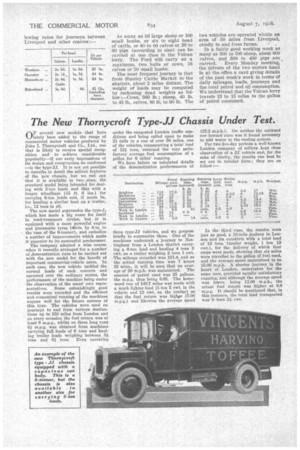The New Thornycroft Type-JJ Chassis Under Test.
Page 60

If you've noticed an error in this article please click here to report it so we can fix it.
0F several new models that have lately been added to the range of commercial motor vehicles produced by John I. Thornycroft and Co., Ltd., one that is likely to receive special recognition and• to achieve considerable popularity-if our early impressions of its design and construction -be confirmed -is the type-JJ. It is not yet possible to describe in detail the salient features of the new chassis, but we call say that it is available in two, sizes, the standard model being intended for dealing with 5-ton loads and that with a longer, wheelbase (15 ft. 6 ins.) for carrying 6-ton ,lotlds and, if needs be, for hauling a similar load on a trailer, i.e., 12 tons in all.
The new model supersedes the type-J, which has made a big name for itself in road-transport circles, but it is equipped with a more powerful engine and pneumatic tyres (40-in. by 8-in. in the case of the 6-tonner), and embodies a number of improvements which make it superior to its successful predecessor.
The company adopted a wise course when it recently arranged for a number of ,demonstration runs to be carried out with the new model for the benefit of important commercial-vehicle users. In each case, the new vehicle tackled the normal loads of each concern and operated over the ordinary routes, the performance of the machine being under the observation of the users' own repre
sentatives. Some astonishingly good results were recorded and the efficient and economical running of the machines augurs well for the future success Of this type. The vehicles were used on journeys to and from various destinations up to 150 miles from London and on every occasion the fuel return was at least 6 m.p.g., whilst on three long runs 6+ m.p.g. was obtained from machines carrying full loads of 6 tons and hauling trailer loads weighing between 3+ tons and 6+ tons. Even operating
under the congested London traffic conditions and being called upon to make 21 calls in a run of over 50 miles, one of the vehicles, transporting a total load of 12+ tons, returned the very satisfactory average fuel consumption of a gallon for 6 miles' running.
We have before us tabulated details of the demonstration performances of
three type-JJ vehicles, and we propose briefly to summarize them. One of the machines undertook a journey to Nottingham from a London district carrying a 6-ton load and hauling 4 tons 3 cwt. on a trailer weighing 2 tons 1 cwt. The mileage recorded was 151.4, and as the actual running time was 7 hours 32 mins., it will be seen that an average of 20 m.p.h. was maintained. The amount of petrol used was 25 gallons, the m.p.g. thus being 6.05. The homeward run of 148.7 miles was made with a much lighter load (1 ton 5 cwt. in the vehicle and 12 cwt. on the trailer) so that the fuel return was blew (7.08 m.p.g.) and likewise the average speed (222 m.p.h.). On neither the outward nor inward runs was it found necessary to add water to the cooling system.
For two five-day periods a well-known London company of millers kept close observation of a J.3vehicle and, for the sake of clarity, the results can best be set out in tabular form ; they are as follow:
In the third case, the results were just as good, a 33-mile journey in London and its outskirts with a total load of 12 tons (trailer weight, 1 ton 12 cwt.), for the delivery of which four stops were made, showing that six miles were travelled to the gallon of fuel used, and the average speed maintained to be 15.06 m.p.h. A shorter journey in the heart of London, undertaken for the same user, provided equally satisfactory running, and although the average speed was lower, being 13.09 m.p.h., the actual fuel return was higher. at 6.8 m.p.g. It :should be mentioned that, in this instance, the total load transported was 8 tons 2+ cwt.




































































































